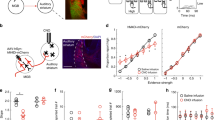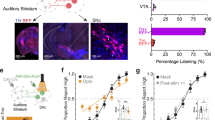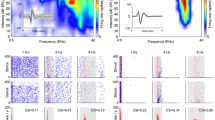Abstract
Perception of complex sounds such as speech is affected by a variety of factors, including attention, expectation of reward, physiological state, and/or disorders, yet the mechanisms underlying this modulation are not well understood. Although dopamine is commonly studied for its role in reward-based learning and in disorders, multiple lines of evidence suggest that dopamine is also involved in modulating auditory processing. In this study, we examined the effects of dopamine application on neuronal response properties in the inferior colliculus (IC) of awake mice. Because the IC contains dopamine receptors and nerve terminals immunoreactive for tyrosine hydroxylase, we predicted that dopamine would modulate auditory responses in the IC. We recorded single-unit responses before, during, and after the iontophoretic application of dopamine using piggyback electrodes. We examined the effects of dopamine on firing rate, timing, and probability of bursting. We found that application of dopamine affected neural responses in a heterogeneous manner. In more than 80 % of the neurons, dopamine either increased (32 %) or decreased (50 %) firing rate, and the effects were similar on spontaneous and sound-evoked activity. Dopamine also either increased or decreased first spike latency and jitter in almost half of the neurons. In 3/28 neurons (11 %), dopamine significantly altered the probability of bursting. The heterogeneous effects of dopamine observed in the IC of awake mice were similar to effects observed in other brain areas. Our findings indicate that dopamine differentially modulates neural activity in the IC and thus may play an important role in auditory processing.




Similar content being viewed by others
References
Adams J (1979) Ascending projections to the inferior colliculus. J Comp Neurol 183:519–538
Adams J, Mugnaini E (1984) Dorsal nucleus of the lateral lemniscus: a nucleus of GABAergic projection neurons. Brain Res Bull 13:585–590
Allen PD, Ison JR (2010) Sensitivity of the mouse to changes in azimuthal sound location: angular separation, spectral composition, and sound level. Behav Neurosci 124:265–277
Allen PD, Ison JR (2012) Kcna1 gene deletion lowers the behavioral sensitivity of mice to small changes in sound location and increases asynchronous brainstem auditory evoked potentials but does not affect hearing thresholds. J Neurosci 32:2538–2543
Aragona BJ, Liu Y, Curtis JT, Stephan FK, Wang Z (2003) A critical role for nucleus accumbens dopamine in partner-preference formation in male prairie voles. J Neurosci 23:3483–3490
Bamford NS, Robinson S, Palmiter RD, Joyce JA, Moore C, Meshul CK (2004) Dopamine modulates release from corticostriatal terminals. J Neurosci 24:9541–9552
Bender KJ, Uebele VN, Renger JJ, Trussell LO (2012) Control of firing patterns through modulation of axon initial segment T-type calcium channels. J Physiol 590:109–118
Braff D, Stone C, Callaway E, Geyer M, Glick I, Bali L (1978) Prestimulus effects on human startle reflex in normals and schizophrenics. Psychophysiology 15:339–343
Brunso-Bechtold JK, Thompson GC, Masterton RB (1981) HRP study of the organization of auditory afferents ascending to central nucleus of inferior colliculus in cat. J Comp Neurol 197:705–722
Calabresi P, Mercuri NB, Sancesario G, Bernardi G (1993) Electrophysiology of dopamine-denervated striatal neurons. Brain 116:433–452
Charlier TD, Ball GF, Balthazart J (2005) Sexual behavior activates the expression of the immediate early genes c-fos and Zenk (egr-1) in catecholaminergic neurons of male Japanese quail. Neuroscience 131:13–30
Drescher MJ, Drescher DG, Khan KM, Hatfield JS, Ramakrishnan NA, Abu-Hamdan MD, Lemonnier LA (2006) Pituitary adenylyl cyclase-activating polypeptide (PACAP) and its receptor (PAC1-R) are positioned to modulate afferent signaling in the cochlea. Neuroscience 142:139–164
Flagel SB, Clark JJ, Robinson TE, Mayo L, Czuj A, Willuhn I, Akers CA, Clinton SM, Phillips PE, Akil H (2011) A selective role for dopamine in stimulus-reward learning. Nature 469:53–57
Frisina D, Walton J, Lynch-Armour M, Klotz D (1998) Inputs to a physiologically characterized region of the inferior colliculus of the young adult CBA mouse. Hear Res 115:61–81
Gáborján A, Lendvai B, Vizi ES (1999) Neurochemical evidence of dopamine release by lateral olivo- cochlear efferents and its presynaptic modulation in guinea-pig cochlea. Neuroscience 90:131–138
Gale SD, Perkel DJ (2010) A basal ganglia pathway drives selective auditory responses in songbird dopaminergic neurons via disinhibition. J Neurosci 30:1027–1037
Gittelman JX, Wang L, Colburn HS, Pollak GD (2012) Inhibition shapes response selectivity in the inferior colliculus by gain modulation. Front Neural Circ 6:67
Gonzalez-Hernandez T, Mantolan-Sarmiento B, Gonzalez-Gonzalez B, Perez-Gonzalez H (1996) Sources of GABAergic input to the inferior colliculus of the rat. J Comp Neurol 372:309–326
Goodson JL, Kabelik D, Kelly AM, Rinaldi J, Klatt JD (2009) Dopamine-beta-hydroxylase and tyrosine hydroxylase immunoreactive neurons in the human brainstem. Proc Natl Acad Sci 106:8737–8742
Govindaiah G, Wang Y, Cox CL (2010) Dopamine enhances the excitability of somatosensory thalamocortical neurons. Neuroscience 170:981–991
Havey D, Caspary DM (1980) A simple technique for constructing piggy-back multibarrel micro-electrodes. Electroencephalogr Clin Neurophysiol 45:249–251
Higley MJ, Sabatini BL (2010) Competitive regulation of synaptic Ca2+ influx by D2 dopamine and A2A adenosine receptors. Nat Neurosci 13:958–966
Holmstrom L, Eeuwes LB, Roberts PD, Portfors CV (2010) Efficient encoding of vocalizations in the auditory midbrain. J Neurosci 30:802–819
Hormigo S, Horta Júnior Jde A, Gómez-Nieto R, López DE (2012) The selective neurotoxin DSP-4 impairs the noradrenergic projections from the locus coeruleus to the inferior colliculus in rats. FrontNeural Circ 6:41
Ison JR, Allen PD (2012) Deficits in responding to brief noise offsets in Kcna1 −/− mice reveal a contribution of this gene to precise temporal processing seen previously only for stimulus onsets. J Assoc Res Otolaryngol 13:351–358
Khurana S, Remme MW, Rinzel J, Golding NL (2011) Dynamic interaction of Ih and IK-LVA during trains of synaptic potentials in principal neurons of the medial superior olive. J Neurosci 31:8936–8947
Kitahama K, Sakamoto N, Jouvet A, Nagatsu I, Pearson J (1996) Dopamine-beta-hydroxylase and tyrosine hydroxylase immunoreactive neurons in the human brainstem. J Chem Neuroanat 10:137–146
Koch U, Grothe B (2003) Hyperpolarization-activated current (Ih) in the inferior colliculus: distribution and contribution to temporal processing. J Neurophysiol 90:3679–3687
Kubikova L, Kostál L (2010) Dopaminergic system in birdsong learning and maintenance. J Chem Anatomy 39:112–123
Kubikova L, Wada K, Jarvis ED (2010) Dopamine receptors in a songbird brain. J Comp Neurol 518:741–769
Kulesza RJ, Spirou GA, Berrebi AS (2003) Physiological response properties of neurons in the superior paraolivary nucleus of the rat. J Neurophysiol 89:2299–2312
Leblois A, Wendel BJ, Perkel DJ (2010) Striatal dopamine modulates basal ganglia output and regulates social context-dependent behavioral variability through D1 receptors. J Neurosci 30:5730–5743
Li L, Korngut LM, Frost BJ, Beninger RJ (1998) Prepulse inhibition following lesions of the inferior colliculus: prepulse intensity functions. Physiol Behav 65:133–139
Lobarinas E, Hayes SH, Allman BL (2013) The gap-startle paradigm for tinnitus screening in animal models: limitations and optimization. Hear Res 295:150–160
Maia T, Frank MJ (2011) From reinforcement learning models to psychiatric and neurological disorders. Nat Neurosci 14:154–162
Maison SF, Liu XP, Eatock RA, Sibley DR, Grandy DK, Liberman MC (2012) Dopaminergic signaling in the cochlea: receptor expression patterns and deletion phenotypes. J Neurosci 32:344–355
Mayko ZM, Roberts PD, Portfors CV (2012) Inhibitory microcircuitry shapes selectivity to vocalizations in the inferior colliculus. Front Neurosci 6:73
Metzger RR, Greene NT, Porter KK, Groh JM (2006) Effects of reward and behavioral context on neural activity in the primate inferior colliculus. J Neurosci 26:7468–7476
Michaeli A, Yaka R (2010) Dopamine inhibits GABA(A) currents in ventral tegmental area dopamine neurons via activation of presynaptic g-protein coupled inwardly-rectifying potassium channels. Neuroscience 165:1159–1169
Muniak MM, Mayko ZM, Ryugo DK, Portfors CV (2012) Preparation of an awake mouse for recording neural responses and injecting tracers. J Vis Exp 64(e3755):1–7
Nicola SM, Surmeier DJ, Malenka RC (2000) Dopaminergic modulation of neuronal excitability in the striatum and nucleus accumbens. Annu Rev Neurosci 23:185–215
Orio P, Parra A, Madrid R, Gonzalez O, Belmonte C, Viana F (2012) Role of Ih in the firing pattern of mammalian cold thermoreceptor endings. J Neurophysiol 108:3009–3023
Paxinos G, Franklin K (2001) The mouse brain in stereotaxic coordinates, 2nd edn. Academic, San Diego
Perez MF, White FJ, Hu XT (2006) Dopamine D(2) receptor modulation of K(+) channel activity regulates excitability of nucleus accumbens neurons at different membrane potentials. J Neurophysiol 96:2217–2228
Phillips PE, Stuber GD, Heien ML, Wightman RM, Carelli RM (2003) Subsecond dopamine release promotes cocaine seeking. Nature 422:614–618
Portfors CV, Roberts PD, Jonson K (2009) Over-representation of species-specific vocalizations in the awake mouse inferior colliculus. Neuroscience 162:486–500
Ramanathan S, Tkatch T, Atherton JF, Wilson CJ, Bevan MD (2008) D2-like dopamine receptors modulate SKCa channel function in subthalamic nucleus neurons through inhibition of Cav2.2 channels. J Neurophysiol 999:442–459
Rinne T, Balk MH, Koistinen S, Autti T, Alho K, Sams M (2008) Auditory selective attention modulates activation of human inferior colliculus. J Neurophysiol 100:3323–3327
Rosenberger MH, Fremouw T, Casseday JH, Covey E (2003) Expression of the Kv1.1 ion channel subunit in the auditory brainstem of the big brown bat, Eptesicus fuscus. J Comp Neurol 462:101–120
Ruel J, Nouvian R, Gervais d’Aldin C, Pujol R, Eybalin M, Puel JL (2001) Dopamine inhibition of auditory nerve activity in the adult mammalian cochlea. Eur J Neurosci 14:977–986
Saint Marie R, Ostapoff RM, Morest D, Wenthold R (1989) Glycine-immunoreactive projection of the cat lateral superior olive: possible role in midbrain ear dominance. J Comp Neurol 279:382–396
Sasaki A, Sotnikova TD, Gainetdinov RR, Jarvis ED (2006) Social context-dependent singing-related dopamine. J Neurosci 35:9010–9014
Satake S, Yamada K, Melo LL, Barbosa Silva R (2012) Effects of microinjections of apomorphine and haloperidol into the inferior colliculus on prepulse inhibition of the acoustic startle reflex in rat. Neurosci Lett 509:60–63
Schultz W (2010) Dopamine signals for reward value and risk: basic and recent data. Behav Brain Funct 6:24
Schultz W (2013) Updating dopamine reward signals. Curr Opin Neurobiol 23:229–238
Schultz W, Dayan P, Montague PR (1997) A neural substrate of prediction and reward. Science 275:1593–1599
Sivaramakrishnan S, Oliver DL (2001) Distinct K currents result in physiologically distinct cell types in the inferior colliculus of the rat. J Neurosci 21:2861–2877
Surmeier DJ, Carrillo-Reid L, Bargas J (2011) Dopaminergic modulation of striatal neurons, circuits and assemblies. Neuroscience 198:3–18
Swerdlow NR, Weber M, Qu Y, Light GA, Braff DL (2008) Realistic expectations of prepulse inhibition in translational models for schizophrenia research. Psychopharmacology (Berlin) 199:331–388
Tan ML, Theeuwes HP, Feenstra L, Borst JG (2007) Membrane properties and firing patterns of inferior colliculus neurons: an in vivo patch-clamp study in rodents. J Neurophysiol 98:443–453
Tierney PL, Thierry AM, Glowinski J, Deniau JM, Gioanni Y (2008) Dopamine modulates temporal dynamics of feedforward inhibition in rat prefrontal cortex in vivo. Cereb Cortex 18:2251–2262
Tobin AE, Calabrese RL (2005) Myomodulin increases Ih and inhibits the Na/K pump to modulate bursting in leech heart interneurons. J Neurophysiol 94:3938–3950
Tong L, Altschuler RA, Holt AG (2005) Tyrosine hydroxylase in rat auditory midbrain: distribution and changes following deafness. Hear Res 206:28–41
Trantham-Davidson H, Neely LC, Lavin A, Seamans JK (2004) Mechanisms underlying differential D1 versus D2 dopamine receptor regulation of inhibition in prefrontal cortex. J Neurosci 24:10652–10659
Turner JG, Brozoski TJ, Bauer CA, Parrish JL, Myers K, Hughes LF, Caspary DM (2006) Gap detection deficits in rats with tinnitus: a potential novel screening tool. Behav Neurosci 120:188–195
Vandecasteele M, Glowinski J, Deniau JM, Venance L (2008) Chemical transmission between dopaminergic neuron pairs. Proc Natl Acad Sci 105:4904–4909
Wamsley JK, Gehlert DR, Filloux FM, Dawson TM (1989) Comparison of the distribution of D-1 and D-2 dopamine receptors in the rat brain. J Chem Neuroanat 2:119–137
Weiner DM, Levey AI, Sunahara RK, Niznik HB, O’Dowd BF, Seeman P, Brann MR (1991) D1 and D2 dopamine receptor mRNA in rat brain. Proc Natl Acad Sci 88:1859–1863
Willott JF (1986) Effects of aging, hearing loss, and anatomical location on thresholds of inferior colliculus neurons in C57Bl/6 and CBA mice. J Neurophysiol 56:391–408
Winer J, Schreiner C (2005) The inferior colliculus. Springer, New York
Xie R, Gittelman JX, Li N, Pollak GD (2008) Whole cell recordings of intrinsic properties and sound-evoked responses from the inferior colliculus. Neuroscience 154:245–256
Acknowledgments
We thank Zachary Mayko for help with data collection. This work was supported by National Science Foundation grant no. IOS-0920060 to CVP.
Author information
Authors and Affiliations
Corresponding author
Rights and permissions
About this article
Cite this article
Gittelman, J.X., Perkel, D.J. & Portfors, C.V. Dopamine Modulates Auditory Responses in the Inferior Colliculus in a Heterogeneous Manner. JARO 14, 719–729 (2013). https://doi.org/10.1007/s10162-013-0405-0
Received:
Accepted:
Published:
Issue Date:
DOI: https://doi.org/10.1007/s10162-013-0405-0




